Merrillville, IN
Munster, IN
April 2024
Causes and Diagnosis of Gout
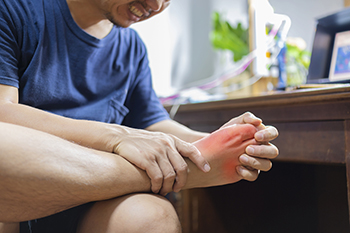
Gout is a type of inflammatory arthritis that often targets the big toe and causes immediate and excruciating pain. Symptoms of gout include sudden swelling, pain, and redness, called flare-ups, and often occur during the night. It is caused by high levels of uric acid that form crystals in the joint. A podiatrist can conduct tests to measure uric acid levels and identify crystals in joint fluid. Treatment aims to alleviate acute flares, prevent further occurrences, and manage the condition long-term to avoid uric acid deposits in tissues. Anti-inflammatory drugs and corticosteroids help manage pain and inflammation during flares, while preventive daily treatments may be necessary for severe cases. Lowering uric acid levels is essential for long-term management, achieved through medication, diet, and lifestyle changes. A podiatrist can offer specialized foot-related care and comprehensive assessments, custom treatment plans, and progress monitoring for effective gout management. If you are experiencing gout symptoms in the feet or ankles, it is suggested that you seek assistance from a podiatrist who can provide tailored care to alleviate discomfort and optimize management strategies.
Gout is a foot condition that requires certain treatment and care. If you are seeking treatment, contact Ahmad Elsamad, DPM from The Institute of Foot & Ankle Reconstructive Surgery . Our doctor will treat your foot and ankle needs.
What Is Gout?
Gout is a type of arthritis caused by a buildup of uric acid in the bloodstream. It often develops in the foot, especially the big toe area, although it can manifest in other parts of the body as well. Gout can make walking and standing very painful and is especially common in diabetics and the obese.
People typically get gout because of a poor diet. Genetic predisposition is also a factor. The children of parents who have had gout frequently have a chance of developing it themselves.
Gout can easily be identified by redness and inflammation of the big toe and the surrounding areas of the foot. Other symptoms include extreme fatigue, joint pain, and running high fevers. Sometimes corticosteroid drugs can be prescribed to treat gout, but the best way to combat this disease is to get more exercise and eat a better diet.
If you have any questions please feel free to contact our offices located in Merrillville, and Munster, IN . We offer the newest diagnostic and treatment technologies for all your foot and ankle needs.
Causes of Foot Arch Pain
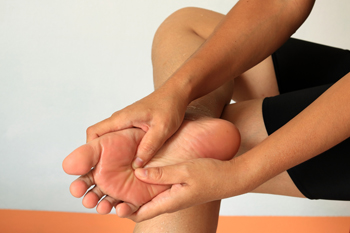
Foot arch pain can affect people of all ages and activity levels. The arches of the foot serve a vital role in absorbing shock and distributing weight during activities like walking, running, and jumping. However, when the arch is strained or stressed, it can lead to discomfort ranging from mild to severe, and may negatively affect your daily activities. Foot arch pain can arise from various causes, including injuries, overuse, and structural differences in the feet. Underlying conditions like plantar fasciitis or posterior tibial tendon dysfunction are other possible causes. Seeking assistance from a podiatrist is necessary for an accurate diagnosis and a tailored treatment plan. A podiatrist specializes in diagnosing and treating foot and ankle conditions through physical examinations and imaging tests in order to identify the root cause of your foot arch pain. Treatment options may include prescription medications, custom orthotics, immobilization devices, or surgery in persistent or severe cases. To alleviate discomfort from foot arch pain and restore your mobility, it is suggested that you schedule an appointment with a podiatrist.
Foot Pain
Foot pain can be extremely painful and debilitating. If you have a foot pain, consult with Ahmad Elsamad, DPM from The Institute of Foot & Ankle Reconstructive Surgery . Our doctor will assess your condition and provide you with quality foot and ankle treatment.
Causes
Foot pain is a very broad condition that could be caused by one or more ailments. The most common include:
- Bunions
- Hammertoes
- Plantar Fasciitis
- Bone Spurs
- Corns
- Tarsal Tunnel Syndrome
- Ingrown Toenails
- Arthritis (such as Gout, Rheumatoid, and Osteoarthritis)
- Flat Feet
- Injury (from stress fractures, broken toe, foot, ankle, Achilles tendon ruptures, and sprains)
- And more
Diagnosis
To figure out the cause of foot pain, podiatrists utilize several different methods. This can range from simple visual inspections and sensation tests to X-rays and MRI scans. Prior medical history, family medical history, and any recent physical traumatic events will all be taken into consideration for a proper diagnosis.
Treatment
Treatment depends upon the cause of the foot pain. Whether it is resting, staying off the foot, or having surgery; podiatrists have a number of treatment options available for foot pain.
If you have any questions, please feel free to contact our offices located in Merrillville, and Munster, IN . We offer the newest diagnostic and treatment technologies for all your foot care needs.
Symptoms of Tarsal Tunnel Syndrome
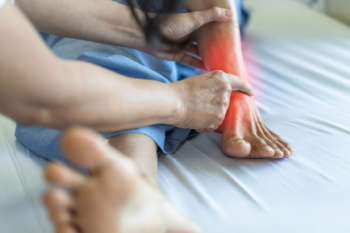 Tarsal tunnel syndrome is a condition that occurs when the tibial nerve, which runs through the inside of the ankle, becomes compressed. This compression can lead to a range of symptoms, commonly including a tingling sensation, numbness, or a burning pain in the foot, especially in the sole or arch. Some people may also experience these sensations extending to the heel, toes, or up into the calf. The discomfort often worsens with activity and can become more pronounced at night. Tarsal tunnel syndrome can be caused by anything that increases pressure in the tarsal tunnel, such as swelling from an injury, flat feet that strain the nerve, or growths like cysts. If you suspect tarsal tunnel syndrome, it is suggested that you seek prompt evaluation from a podiatrist.
Tarsal tunnel syndrome is a condition that occurs when the tibial nerve, which runs through the inside of the ankle, becomes compressed. This compression can lead to a range of symptoms, commonly including a tingling sensation, numbness, or a burning pain in the foot, especially in the sole or arch. Some people may also experience these sensations extending to the heel, toes, or up into the calf. The discomfort often worsens with activity and can become more pronounced at night. Tarsal tunnel syndrome can be caused by anything that increases pressure in the tarsal tunnel, such as swelling from an injury, flat feet that strain the nerve, or growths like cysts. If you suspect tarsal tunnel syndrome, it is suggested that you seek prompt evaluation from a podiatrist.
Tarsal tunnel syndrome can be very uncomfortable to live with. If you are experiencing tarsal tunnel syndrome, contact Ahmad Elsamad, DPM of The Institute of Foot & Ankle Reconstructive Surgery . Our doctor can provide the care you need to keep you pain-free and on your feet.
Tarsal Tunnel Syndrome
Tarsal tunnel syndrome, which can also be called tibial nerve dysfunction, is an uncommon condition of misfiring peripheral nerves in the foot. The tibial nerve is the peripheral nerve in the leg responsible for sensation and movement of the foot and calf muscles. In tarsal tunnel syndrome, the tibial nerve is damaged, causing problems with movement and feeling in the foot of the affected leg.
Common Cause of Tarsal Tunnel Syndrome
- Involves pressure or an injury, direct pressure on the tibial nerve for an extended period of time, sometimes caused by other body structures close by or near the knee.
- Diseases that damage nerves, including diabetes, may cause tarsal tunnel syndrome.
- At times, tarsal tunnel syndrome can appear without an obvious cause in some cases.
The Effects of Tarsal Tunnel Syndrome
- Different sensations, an afflicted person may experience pain, tingling, burning or other unusual sensations in the foot of the affected leg.
- The foot muscles, toes and ankle become weaker, and curling your toes or flexing your foot can become difficult.
- If condition worsens, infections and ulcers may develop on the foot that is experiencing the syndrome.
A physical exam of the leg can help identify the presence of tarsal tunnel syndrome. Medical tests, such as a nerve biopsy, are also used to diagnose the condition. Patients may receive physical therapy and prescriptive medication. In extreme cases, some may require surgery.
If you have any questions please feel free to contact our offices located in Merrillville, and Munster, IN . We offer the newest diagnostic and treatment technologies for all your foot and ankle needs.
Types of Wound Care for Gangrene
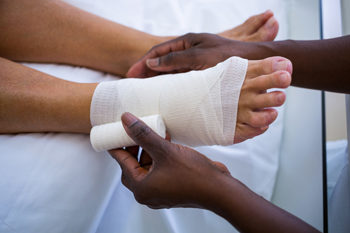
Gangrene, the consequence of compromised blood supply to the lower limbs and feet, occurs in three primary forms, which consist of dry, wet, and gas gangrene. Dry gangrene, stemming from arterial blockage, progresses slowly and necessitates vascular intervention for blood flow restoration. This type of gangrene is often seen in patients with arteriosclerosis or diabetes. Wet gangrene is caused by an infected wound that is left untreated. Wound care for gangrene involves surgical debridement to remove dead tissue and antibiotics to combat bacterial proliferation. Gas gangrene, caused by clostridia bacteria, requires aggressive debridement and targeted antibiotics to prevent systemic spread. A podiatrist plays an important role in managing gangrenous wounds in the lower limbs and feet to keep the condition from worsening. If you have ulcerated wounds that have turned gangrenous, it is strongly suggested that you seek prompt assessment by a podiatrist and get immediate treatment to avoid loss of limb.
Wound care is an important part in dealing with diabetes. If you have diabetes and a foot wound or would like more information about wound care for diabetics, consult with Ahmad Elsamad, DPM from The Institute of Foot & Ankle Reconstructive Surgery . Our doctor will assess your condition and provide you with quality foot and ankle treatment.
What Is Wound Care?
Wound care is the practice of taking proper care of a wound. This can range from the smallest to the largest of wounds. While everyone can benefit from proper wound care, it is much more important for diabetics. Diabetics often suffer from poor blood circulation which causes wounds to heal much slower than they would in a non-diabetic.
What Is the Importance of Wound Care?
While it may not seem apparent with small ulcers on the foot, for diabetics, any size ulcer can become infected. Diabetics often also suffer from neuropathy, or nerve loss. This means they might not even feel when they have an ulcer on their foot. If the wound becomes severely infected, amputation may be necessary. Therefore, it is of the upmost importance to properly care for any and all foot wounds.
How to Care for Wounds
The best way to care for foot wounds is to prevent them. For diabetics, this means daily inspections of the feet for any signs of abnormalities or ulcers. It is also recommended to see a podiatrist several times a year for a foot inspection. If you do have an ulcer, run the wound under water to clear dirt from the wound; then apply antibiotic ointment to the wound and cover with a bandage. Bandages should be changed daily and keeping pressure off the wound is smart. It is advised to see a podiatrist, who can keep an eye on it.
If you have any questions, please feel free to contact our offices located in Merrillville, and Munster, IN . We offer the newest diagnostic and treatment technologies for all your foot care needs.
It's Time for Beautiful Feet
Safe Removal of Corns on the Feet
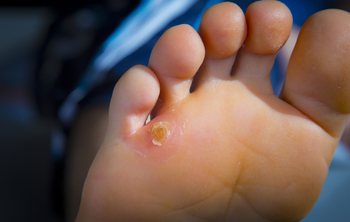
When dealing with corns on the feet, it is important to prioritize safe removal techniques, particularly if you have underlying health conditions, like diabetes. Seeking professional help from a podiatrist is essential, especially if the corns are painful or if there are concerns about infection or other complications. A podiatrist may use various methods for safe corn removal, including trimming them with a small knife or applying salicylic acid patches to soften them. These procedures are performed in a controlled medical setting to minimize the risk of infection. Additionally, the podiatrist may address underlying structural issues that can contribute to corn formation, such as bunions or hammer toes. It is important to refrain from attempting corn removal yourself, especially for individuals with diabetes or circulation problems. If you have a problem with a corn on the foot, it is suggested that you schedule an appointment with a podiatrist for its safe removal.
If you have any concerns regarding your feet and ankles, contact Ahmad Elsamad, DPM of The Institute of Foot & Ankle Reconstructive Surgery . Our doctor will treat your foot and ankle needs.
Corns: What Are They? and How Do You Get Rid of Them?
Corns can be described as areas of the skin that have thickened to the point of becoming painful or irritating. They are often layers and layers of the skin that have become dry and rough, and are normally smaller than calluses.
Ways to Prevent Corns
There are many ways to get rid of painful corns such as wearing:
- Well-fitting socks
- Comfortable shoes that are not tight around your foot
- Shoes that offer support
Treating Corns
Treatment of corns involves removing the dead skin that has built up in the specific area of the foot. Consult with Our doctor to determine the best treatment option for your case of corns.
If you have any questions please feel free to contact our offices located in Merrillville, and Munster, IN . We offer the newest diagnostic and treatment technologies for all your foot and ankle needs.








